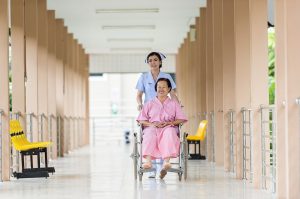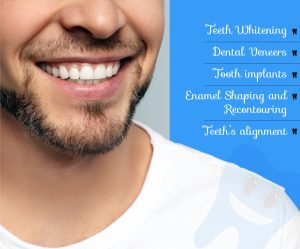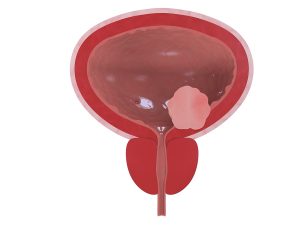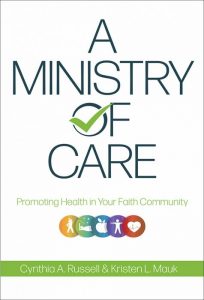Dr. Mauk’s Boomer Blog
Each week, Dr. Kristen Mauk shares thoughts relevant to Baby Boomers that are aimed to educate and amuse.
Dr. Kristen L. Mauk, PhD, DNP, RN, CRRN, GCNS-BC, GNP-BC, FAAN

Guest Blog: How the Internet Has Changed How Society Cares for Seniors
Today’s technology is not only for the young. The digital age has brought with it innovations which aim to benefit seniors. A new age of Internet of Things (IoT) devices has made senior care better, more efficient and less costly. It aims to eliminate isolation, which has been a major concern for many years. It has provided caregivers in the healthcare industry a tool to allow seniors to be more independent and remain connected with friends and family.
When it comes to senior care, the IoT is revolutionizing the way seniors are living their lives. Assisted living communities are using the internet to connect and humanize senior care. Communities such as the K4Community leverage technology to make seniors’ life simpler, healthier and happier. These communities integrate IoT wearables such as watches or belt clips. They also have floor sensors that provide real-time monitoring to prevent falls and other injuries. Other types of sensors monitor heart rate, blood pressure and oxygen levels to immediately alert caregivers when there’s an emergency.
To lead a healthy, active lifestyle, IoT devices go beyond the standard activity trackers. Devices are more targeted towards the individual’s needs, alerting them when to rest, whether they’re standing up or down too fast and when to give their knees a break. Food and hydration is also considered, with wearables reminding seniors when it’s time to eat and how often to drink to maintain proper hydration. When it comes to sleep, sensors can also alert caregivers whether a senior needs help getting in and out of bed. With the internet being all about connection, keeping seniors in contact with friends and family is one of the best things the IoT can provide to improve senior health. Seniors are spending more time online, using social networks and other platforms to connect with loved ones.
This trend is only going to get more prevalent. Research shows that using the internet makes people happier and increases life satisfaction, especially for seniors. A study published in the Journal of Computers in Human Behavior shows that life satisfaction was much higher among seniors who use the internet than those who don’t. The ability to keep in touch and prevent the cycle of loneliness and isolation in an advanced age has done more for senior health than any medication. It is no wonder then that internet use among seniors rose from 8% to 34% between 2003 and 2012, as cited by the Journalist’s Resource. The empowerment that the internet and technology have given seniors is invaluable to their health. Such developments revolutionized the way society and healthcare providers care for the elderly.
With Baby Boomers contributing to an increasingly aging population, the need for caregivers and connected assisted living communities is becoming greater than ever. In order to provide quality healthcare to seniors, healthcare is not just about technology but also about the people who provide it. Maryville University details how general healthcare workers can specialize in senior services to provide care for an aging population. Healthcare and senior care are becoming two of the fastest-growing industries. Boosted with the aid of technology and IoT devices, they provide a way to create a better quality of life for seniors, while reducing the costs of healthcare at the same time.
Article submitted by Tanya Olivers
Markham Smile Center: Best Ideas for Your Cosmetic Dental Smile Makeover
A smile is contagious and can uplift the mood of other people. Be it from simple things or bigger ones, we smile to show that we are glad about it. Sometimes we lose what we call spark in us. There are situations in our life that we lose our confidence to smile, not because we are unhappy, but because our teeth don’t look that good. Many people lose their self-confidence because of their teeth.
Thus, these problems could still be fixed with the help of experts. Bringing back the smile you once have will not be a problem anymore as Dental Makeovers are here to save your day. To address the specific problem, you have the Cosmetic Dental Smile Makeovers. It could help you with your teeth problems and bring back the best smile you’ve ever had.
Ideas for a Smile Makeover
- Teeth Whitening
People especially those who are into smoking, as well as those who have poor oral hygiene, are prone to tooth discoloration. Many individuals have undergone this problem. And, it truly affects their day-to-day interaction with others. Good thing, there’s a solution to confront this issue today. The teeth whitening solution is the answer for teeth discoloration. The process is mainly done with the guidance of the dentist. A solution is applied to your teeth that will penetrate and break the stains on your teeth surfaces. So, if you have a problem similar to this, you can visit your dentist and undergo a tooth whitening procedure.
- Dental Veneers
Aren’t you happy with how your teeth look? Well, these might be the solutions you’ve been looking for. This process is mainly the solution given for individuals who have an issue with their teeth appearance. Improving the way your teeth look with this procedure is helpful. It covers your tooth that changes its color, size, shape, and even length.
Dental Veneers are longer-lasting, which means you just need to visit your dentist from time to time. This is to keep them safe from any crack and damages. Thus, the cost of this solution is expensive yet if you can afford this, you can bring back the best smile you’ve ever had then.
- Tooth Implants
Tooth Implants or Dental Implants are the processes employed for patients who want to have an artificial tooth. This process replaces the old tooth you have by attaching a metal, screw-like one on your gums beneath the jaw or skull and covered with replacement or permanent teeth that will act as your tooth later on.
This may sound too painful and may take 1-2 weeks for its initial healing process for 3-6 months. The dentist attaches the implants to the jaw’s bone. Thus, the result will surely satisfy your need. Especially for some who lose their tooth due to decay, you can still bring back the tooth in its new and hefty capability.
- Enamel Shaping and Recontouring
It is often called cosmetic contouring or Enameloplasty. This process is done to help people with unequal shapes and with sharp-edged dental imperfections. This changes the form making it look perfect and free of any unbalance forms. The process goes where enamel (the hard-protecting layer of your tooth) is reshaped through drilling or laser. This process is often quick and painless. This event doesn’t require any recovery period. Visit your dentist to check whether these solutions are right for the problem you have.
- Teeth Alignment
This might be the most common dental procedure undergone by many today. Teeth alignment is the process where your teeth are arranged perfectly fit and straightened as well. This comes often under braces and clean teeth aligners where people who have imperfect tooth growth commonly choose.
Having your teeth aligned makes it more pleasing and healthier. It protects your gums especially those who have issues with separated teeth. Well, if you wish you have this procedure, there are some precautions you need to consider. Also, you need to visit your dentist to have it fixed when it becomes loose.
Benefits of Getting a Smile Makeover
Having a dental makeover gives us a lot of benefits. Because it could keep our teeth healthy, for some people who have lost or missing teeth, it could help them restore these. For people who have a misshapen or discolored tooth, a dental makeover could fix them in just a period.
These procedures being discussed give back the natural look of the patient’s teeth, smiling at them like they used to have.
Conclusion
It is important to take care of our teeth, especially when we are still young. As we grow older, we lose the elasticity of our teeth. And, this leads to some dental problems which eventually make us suffer. Thus, before we think of undergoing these solutions, as early as today we must be really careful.
By doing the most common way of protecting your teeth which is brushing you could protect them. Thus, for some who have this kind of issue when they are still young, they could still address the problem with these dental solutions.
If you wish to address this kind of issue, you can visit your nearest dental clinic and have them give you the best solution to your problem.
Bladder Cancer Risk Factors and Treatment
Background
This type of cancer occurs mainly in older adults, with an average age at diagnosis of 73 years, with 9 out of 10 cases of bladder cancer diagnosed in persons over age 55. The American Cancer Society (ACS)(2012) reported that over 73,000 cases were diagnosed in 2012 and that this diagnosis rate has been relatively stable over the last 20 years. Men are three times as likely to get cancer of the bladder as women (American Foundation for Urologic Disease, 2008) and the incidence increases with age.
Risk Factors
Risk factors include chronic bladder irritation and cigarette smoking, the latter contributing to over half of cases. Male gender and age are also risk factors.
Warning signs
The classic symptom of bladder cancer is painless hematuria (blood in the urine). Older adults may attribute the bleeding to hemorrhoids or other causes and feel that because there is no pain, it must not be serious.
Diagnosis
Assessment begins with a thorough history and physical. Diagnosis may involve several tests including an intravenous pyelogram (IVP), urinalysis, and cystoscopy (in which the physician visualizes the bladder structures through a flexible fiber-optic scope). This is a highly treatable type of cancer when caught early. In fact, the ACS (2012a ) estimates that there were more than 500,000 survivors of this cancer in 2012.
Treatment
Once diagnosed, treatment depends on the invasiveness of the cancer. Treatments for bladder cancer include surgery, radiation therapy, immunotherapy, and chemotherapy (ACS, 2012). Specifically, a transurethral resection (TUR) may involve burning superficial lesions through a scope. Bladder cancer may be slow to spread, and less invasive treatments may continue for years before the cancer becomes invasive or metastatic, if ever. Certainly chemotherapy, radiation, and immune (biological) therapy are other treatment options, depending on the extent of the cancer.
Immune/biological therapy includes Bacillus Calmette-Guérin (BCG) wash, an immune stimulant that triggers the body to inhibit tumor growth. BCG treatment can also be done after TUR to inhibit cancer cells from re-growing. Treatments are administered by a physician directly into the bladder through a catheter for 2 hours once per week for 6 or more weeks (Mayo Clinic, 2012a). The patient may be asked to lay on his/her stomach, back, and or sides throughout the procedure. The patient should drink plenty of fluids after the procedure and be sure to empty the bladder frequently. In addition, because the BCG contains live bacteria, the patient should be taught that any urine passed in the first six 6 hours after treatment needs to be treated with bleach: One cup of undiluted bleach should be placed into the toilet with the urine and allowed to sit for 15 minutes before flushing (Mayo Clinic, 2012a).
If the cancer begins to invade the bladder muscle, then removal of the bladder (cystectomy) is indicated to prevent the cancer from spreading. Additional diagnostic tests will be performed if this is suspected, including CT scan or MRI. Chemotherapy and/or radiation may be used in combination with surgery. When the cancerous bladder is removed, the person will have a urostomy, a stoma from which urine drains into a collection bag on the outside of the body, much like a colostomy does. Bleeding and infection are two major complications after surgery, regardless of type, whether a TUR or cystectomy is performed. Significant education of the patient related to intake/output, ostomy care, appliances, and the like is also indicated.
http://www.cancer.gov/cancertopics/wyntk/bladder/
Adapted from Mauk, K. L., Hanson, P., & Hain, D. (2014). Review of the management of common illnesses, diseases, or health conditions. In K. L.
Mauk’s (Ed.) Gerontological Nursing: Competencies for Care. Sudbury, MA: Jones and Bartlett Publishers. Used with permission.
Interview with Chad Jukes – Mountaineer
IRC’s interview with Chad Jukes. Chad lost his limb while serving in Iraq and now is a prolific mountain climber. Follow his upcoming climb in Ecuador with the Range of Motion Project (ROMP) in July on our social media. Dan Easton, our Social Media Director for IRC, will also be climbing with Chad and the elite ROMP team.
A Ministry of Care
A Ministry of Care
Promoting Health in Your Faith Community
Churches tend to focus—rightly so—on spiritual care for parishioners, but what if your church also had a healthcare ministry? Health-related concerns affect the majority of individuals at some point in their lives. Whether it’s facilitating healthcare clinics, hosting seminars by medical professionals, or helping congregants navigate the complex healthcare system, A Ministry of Care explores a variety of ways for any church to become a place where people can be ministered to in spirit, mind, and body. Advanced practice nurses Cynthia Russell and Kristen Mauk guide you through the steps toward starting and sustaining a health-oriented ministry in your church. Pastors, church board members, or motivated lay members can take advantage of the professional tips and advice shared in this handbook in order to better care for the physical well-being of the members in their church and the community beyond.
Cynthia A. Russell
Dr. Cynthia A. Russell is dean and professor of nursing at Holy Family
University, School of Nursing and Allied Health Professions in Philadelphia,
Pennsylvania. Prepared as a psychiatric mental health clinical nurse
specialist, she is also a certified health and wellness coach. She is the
mother of five children and grandmother to four.
Kristen L. Mauk
Dr. Kristen L. Mauk has nearly forty years of teaching and clinical
experience in rehabilitation and gerontology. She is a professor of nursing
and the graduate program director at Colorado Christian University. Dr.
Mauk is the mother of eight children.
Guest Blog: 3 Essential Tips in Senior Foot Care
Due to decades of intense usage, the inevitable process of aging can be particularly taxing on your feet. However, foot troubles are not necessarily an unavoidable part of getting older, and there are many actions one can take to maintain healthy feet beyond their years.
Here are the three main factors you need to consider:
1. Hygiene
The foot is like any part of the body, and if you neglect its cleanliness, then you are bound to end up with some undesirable effects. It’s a good idea to wash your feet every day with a mild soap while using a foot scrubber to smooth off any dead skin.
After a good soak, you may want to trim those softened nails by using clippers to cut straight across, careful to avoid sharp corners that may become ingrown toenails. It’s also important to note that you should never put socks on wet feet, as bacteria thrive in damp conditions and a fungal infection could be quick to follow.
2. Footwear
A bad shoe can not only cause an array of displeasing foot conditions (including bunions, hammer toes, and Achilles tendinitis) but can also inflict trauma on your knees and posture. Always choose comfort over fashion, get every shoe professionally fitted, and ask about the best insole for your arch shape to prevent foot pain.
If mobility has become a problem for you, then test out an assistive walking device. Whether a cane, a rollator, or a mobility scooter, there are so many options to choose from that you will easily find something to suit your exact needs.
3. Attention
Your foot cramp might be telling you something, so don’t ignore it! There is a good chance that these muscle contractions are related to your diet, hence why you should always load your plate up with fruits and vegetables. This may also be the perfect excuse to go out and get a nice relaxing foot massage.
Another essential aspect of foot care is to regularly inspect your skin for any new marks or sores, taking note of everything that wasn’t there before including ulcers, corns, and ingrown toenails. If you’re in doubt about anything you discover, it’s better to be safe than sorry and speak to a medical professional. Remember: the sooner something hazardous is caught, the easier it will be to repair.





